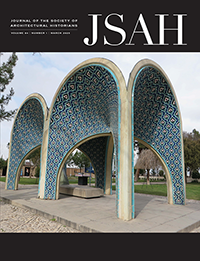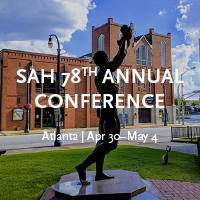The Society of Architectural Historians is pleased to announce three new grants totaling $16,200 awarded to AIA Chicago Chapter, Chicago Architecture Center, and Seattle Architecture Foundation. Read below how each recipient will connect with learners.
These grants help fund awe-inspiring design education programs for youth and docent-led architecture and landscape tours administered by nonprofit organizations. Since its inception, the program has supported architectural and cultural heritage organizations, house museums, creative placemaking sites, summer workshops focusing on architecture and design, schools of architecture with youth outreach programs, and arts and architecture high schools.
SAH established the Field Trip program in 2015 through an anonymous gift from a generous SAH member. The goal of the grant program is to share the wonders of architecture and landscapes with students whose educational interests in the arts and humanities have been underserved due to racial, social, or economic inequity.
AIA Chicago Chapter - Awarded $4,000
Location: Chicago, Illinois
Program Title: Architects in Schools Field Trip
Program Director: Allison Garwood Freedland
Dates: September 2024–May 2025
Program Description:
The field trip is a session of the 8-week Architects in Schools (AIS) program, which is an initiative focused on bringing architecture professionals into classrooms to introduce middle school students to the field of architecture and to discuss the broader theme of architecture as community influencer and changemaker. Volunteers engage the students in critically analyzing their neighborhood for opportunities to create positive change and utilizing architecture as a means for implementing solutions. Through project-based learning, students are introduced to design thinking skills, taught how to communicate their ideas, and encouraged to be thoughtful about planning and designing in their own environments/neighborhoods.
After working in their neighborhoods and understanding how architecture impacts a neighborhood, we take them outside of their community into the Chicago Loop on a 90-minute Loop walking tour. The docent-led tour pairs eight significant buildings with eight architectural themes to help students understand how the built environment impacts our lives, reinforcing the idea that architecture, large or small, is an influencer. A significant number of the students have never left their neighborhood to travel downtown.
Following the Loop tour, the students tour a downtown design firm. They have an opportunity to see the inner workings of a design firm and meet several architects and professionals working in various capacities within the firm. Students have toured Gensler, Partners by Design, Perkins + Will, Harley Ellis Devereaux, bKL Architects and site design group, ltd. The goal is to offer the students a glimpse of a professional workplace experience. The combination of the two types of tours exposes students to the history and influence of the built environment of Chicago as well as a framework of the architecture profession.
Chicago Architecture Center - Awarded $5,000
Location: Chicago, Illinois
Program Title: Discovering Why Design Matters
Program Director: Krista Taylor
Dates: July 2024–July 2025
Program Description:
CAC's field trips program facilitates on-the-ground exploration of Chicago’s built environment, building students' science, technology, engineering, arts, and mathematics skills by presenting lessons grounded in the past, present, and future of Chicago architecture.
Educators choose from three field trip categories:
(1) Standing Workshops at CAC: Standing workshops present evergreen topics such as: "LEGO Inspiration," where LEGO building blocks become a medium for students to learn how architects take an idea to materialization; “Science of Architecture," which takes students into Chicago's Loop neighborhood to learn about the engineering of tall buildings; and "Design Your Neighborhood," a lesson in urban planning and community development tied to an activity building scale models of neighborhoods.
(2) Rotating Exhibit Experiences at CAC: These experiences are based on current exhibits. The newest interactive field trip explores "LOOP as LAB," which utilizes Chicago's Loop neighborhood to illustrate pressing challenges facing downtown districts across the nation. It includes a guided tour of CAC’s galleries and a related hands-on design challenge.
(3) Docent-led Tours in Chicago’s Neighborhoods: Students partake in docent-led walking and bus tours, such as "Historic Treasures of Chicago’s Gilded Age" to explore 1890-1930s buildings along Michigan Avenue and State Street, and “Historic Skyscrapers” to see Chicago's skyscrapers submitted to the UNESCO World Heritage List. CAC works with educators to identify one of our 85 tours that best fits their lesson plans.
Seattle Architecture Foundation - Awarded $7,200
Location: Seattle, Washington
Program Title: From Skid Row to Skyscrapers, A History of Seattle Through its Buildings
Program Director: Gwen Lennox
Dates: July 2024–July 2025
Program Description:
Through exposure to various aspects of architecture in Seattle and the design of the built environment, students will understand how and why the city developed as it did as well as the importance of its design. It will also, hopefully, inspire many to consider design as a career.
Field trip participants will visit Downtown Seattle and a nearby historic neighborhood, Pioneer Square. Sites have been selected to reflect a variety of time periods and their characteristic architectural styles. Structures to be visited include:
(1) The Smith Tower, opened in 1914, this 38-story building was the tallest building west of the Mississippi River at the time.
(2) The Seattle Tower, an Art Deco Building, completed in 1928.
(3) 1201 Third Avenue, a Post-Modern building.
(4) The Seattle Public Library, a relatively modern yet already iconic building in downtown.
(5) Freeway Park, a unique, well landscaped park, much of it spanning I-5. It was one of the earliest parks spanning a freeway.
Students, teachers and SAF staff will reflect on these experiences through conversations that reinforce the field trips' learning goals and themes. These activities will stimulate their perception of the city.
For more information about a specific field trip program, please contact the organizations directly.
Cover image: Middle school tour group overlooks the Chicago River. Credit: AIA Chicago.


